ARVALIS Trial: Testing Nox Process for Effective Grain Pest Protection
This article is taken from the Arvalis Storage Letter (No. 13, originally published in September 2020).
Copyright ©ARVALIS - Institut du végétal 2020.


Grain storage in Nox® Big Bags: a physical process for pest protection.
The French cereal industry has affirmed its commitment to reducing the proportion of cereals containing insecticide residues. However, commercial contract requirements have not been relaxed, and storage companies are required to provide customers with goods that are free of live insects. Insecticides must therefore be gradually replaced by alternative control methods that leave no residues on the grains. These include physical control solutions. Although still little used, physical control is particularly well suited to storage, as the environment is partially controllable.
Hypercapnia: a principle used to eliminate pests by storing grains in Nox® Big Bags.
The Nox® process consists of storing grains in double-layered, airtight big bags and increasing the CO₂ concentration inside them. These big bags form a physical barrier that prevents pests from entering from outside. Insects that are already present in the grains stored in this way are then subjected to a CO₂-enriched atmosphere and find themselves in conditions of hypercapnia (excess CO₂). Various studies have shown that this excess CO₂ endangers the survival of the main species of predators of stored cereals (BANKS and ANNIS, 1990; FLEURAT-LESSARD, 1990; JAVAS and JEYAMKONDAN, 2002).. The biological mechanisms explaining their mortality are still unknown, but it would appear that hypercapnia causes them to become immobilized and their spiracles (respiratory openings on both sides of their abdomen) to remain permanently open, preventing them from regulating their water loss. The lethal exposure time for the insect varies depending on the species, its stage of development, and the temperature of the environment that governs its activity and respiration.
Storage in the Nox® Big Bags: how does it work?
The first step in storing grain using the Nox® process is to unfold the big bag and use a blower. It is essential to inflate the bag and stretch the inner liner to avoid any folds that could affect the big bag's watertightness under the weight of the grain.
The bag can then be filled with grain by standing under a hopper and holding the inner layer of the bag to prevent it from slipping. Care must be taken to fill the bag to only 4/5 of its total capacity in order to leave enough space inside for CO₂.
A heat sealer is required to seal and hermetically close the upper layers of the inner wall of the bag.
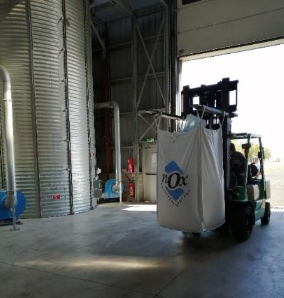

Forklift truck transporting a Nox® Big Bag
A partial vacuum is then created using a vacuum cleaner connected to the suction valve at the top of the inner wall of the bag. The air inside is sucked out until the bag is completely compacted.
The internal CO₂ content of the bag then increases: a food-grade CO₂ cylinder and an injection kit (supplied with the big bags) are assembled and connected to the big bag valve to inflate it with CO₂.
The filled big bag is now ready to be stored in the building at ambient temperature. It is not necessary to store it in a cold room, as this would slow down the insecticidal action of the process.
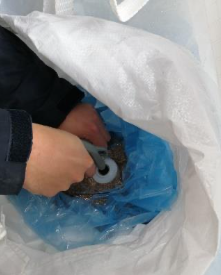

Injection of CO₂ into the Nox® Big Bag
An ARVALIS trial to test the effectiveness of this method against adult and hidden forms of rice weevils and grain weevils
In this trial, nine Nox® Big Basg containing infested wheat cages were placed among the total wheat mass, as described above. When filling the big bags, cages containing 500 g of grain infested with adult and larval forms of rice weevils (Sitophilus oryzae) and grain beetles (Rhyzopertha dominica) were placed at three different heights in the grain mass as it was filled. Some were placed in the first few centimeters of the grain mass, others at mid-height, and the last ones were placed on the surface of the grain at the end of filling. The aim was to verify the homogeneity of the treatment within a big bag.
At the same time, three untreated metal containers were also filled with the same soft wheat (Sacramento variety, 2019 harvest), in which cages infested with the same two insect species were placed at three different heights, as in the big bags. We thus had three replicates (infested cages) for each treatment method. All of these containers were kept at ambient temperature in the ARVALIS - Institut du végétal (91) cereal technology hall during September 2019. The average temperature in the grains was 18.6 ± 1.5 °C and the average relative humidity was 53.7 ± 5.3% during the trial.
Adult insects are eliminated in just 2 days
Three big bags were emptied completely and simultaneously on three different dates in order to recover the infested cages housed in the grain and thus observe the mortality of the adults of the two target species. One third of the cages housed in the control containers, for each of the three heights, were also recovered on the same dates as the big bags were emptied. These observation dates occurred 2, 7, and 20 days after the wheat was packaged.
The increase in CO₂ content in the big bags killed 100% of adult rice weevils and grain weevils in just two days, regardless of the position of the insects within the grain mass (Figure 1). The CO₂ level was therefore sufficient at all points in the big bag to cause total mortality of adult insects. In contrast, a low natural mortality rate of 2 to 3% was observed in the untreated control cages, confirming the insecticidal effect of the Nox® process. The following observations, made on infested cages from big bags emptied 7 to 20 days after packaging, confirmed these results, with total mortality of adults in both species.
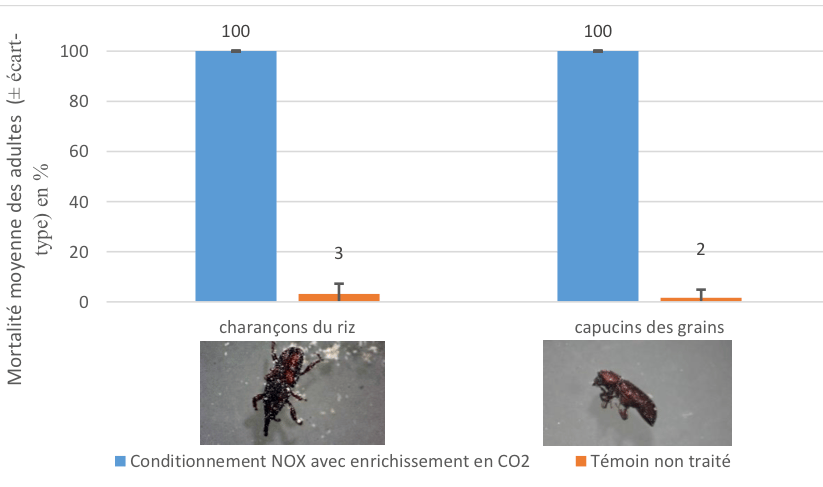

Figure 1: Average mortality of adults of the two pest species studied (rice weevils and grain weevils) according to wheat packaging for 2 days.
Their offspring are eradicated within 1 to 3 weeks
After evaluating adult mortality on each date, the contents of the cages were stored and incubated (at 25°C and 70% relative humidity) to assess the effectiveness of the treatment on the emergence of juvenile forms of both species. After 6 to 8 weeks of incubation, depending on the species, all the offspring that emerged in the Nox® Big Bags wheat batches were counted and compared with those counted in the control cages.
In the case of rice weevils, their offspring were significantly reduced, by 44%, after 2 days of Nox® treatment, but it was necessary to wait 20 days before emptying the big bags to achieve total disinfestation for this species (figure 2).
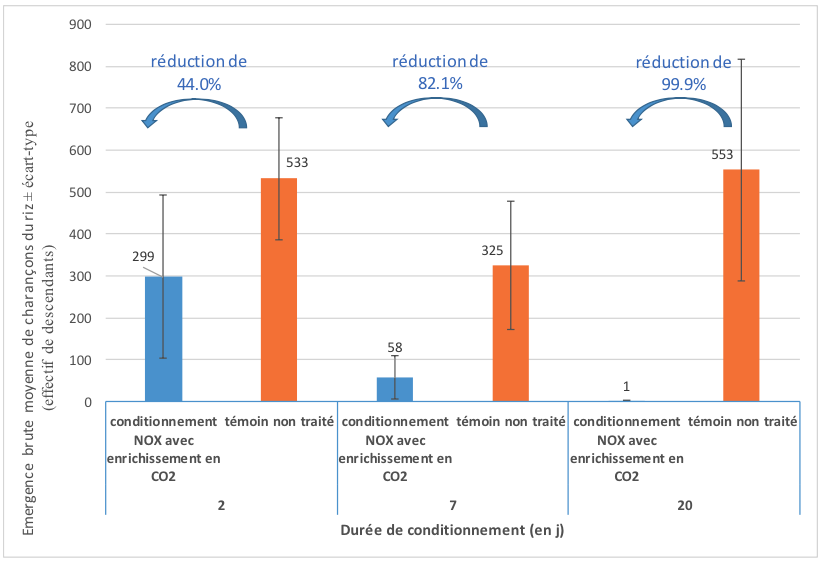

Figure 2: Average gross emergence (i.e., total number of offspring) of rice weevils in the different wheat samples according to their packaging, in big bags with a CO₂-enriched atmosphere or in open-air containers.
The offspring of grain weevils are clearly more sensitive to hypercapnia, as a decrease in emergence of more than 57% was observed after just two days in Nox® Big Bags, reaching 100% in only one week (figure 3).
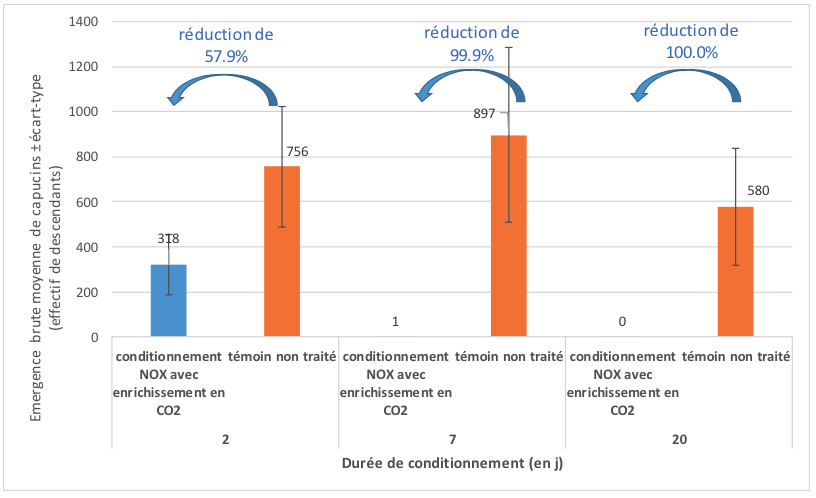

Figure 3: Average gross emergence (i.e., total number of offspring) of grain weevils in different wheat samples according to their packaging, in big bags with a CO₂-enriched atmosphere or in open containers.
The positioning of the insects in the big bag had no significant effect on the reduction in offspring produced by the treatment, either for the rice weevil or the grain beetle. These results therefore suggest that the CO₂ content is homogeneous throughout the big bag, or at least that it is sufficiently high at all points for disinsectization to occur at the same rate.
The main disadvantage of this solution is its cost. It is estimated at between $20 and $25 per ton if the big bag is reused three times (the length of the filling and emptying sheets allows them to be welded several times), including the cost of food-grade CO₂, but to which must be added the cost of equipment for injecting the gas and welding the big bags (which may be rented) and labor time.
This method is therefore mainly intended for agricultural products with higher added value than soft wheat, or to fulfill specific contracts that are more lucrative for storers.
The Nox® Big Bags are proving to be an interesting alternative for preventive or curative use against stored grain pests.
An effective treatment, but at what cost?
Scientific references
BANKS H.J., ANNIS P.P., 1980. Conversion of existing grain storage structures for modified atmosphere use. In: Shejbal L. (Eds) Controlled atmosphere storage of grains. Elsevier Scientific Publishing Company, Amsterdam.
FLEURAT-LESSARD, F., 1990. Effect of modified atmospheres on insect and mites infesting stored products. In: Food Preservation by Modified Atmospheres. Calderon, M., Barkai-Golan, R. (Eds), CRC press, Inc., Boca Raton.
JAYAS D.S., JEYAMKONDAN S., 2002. Modified Atmosphere Storage of Grains, Meats, Fruits, and Vegetables. Biosystems Engineering (2002) 82 (3), 235–251.
Article written by Marine CABACOS
Copyright © ARVALIS - Institut du végétal 2020
